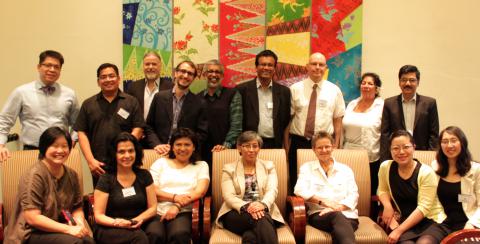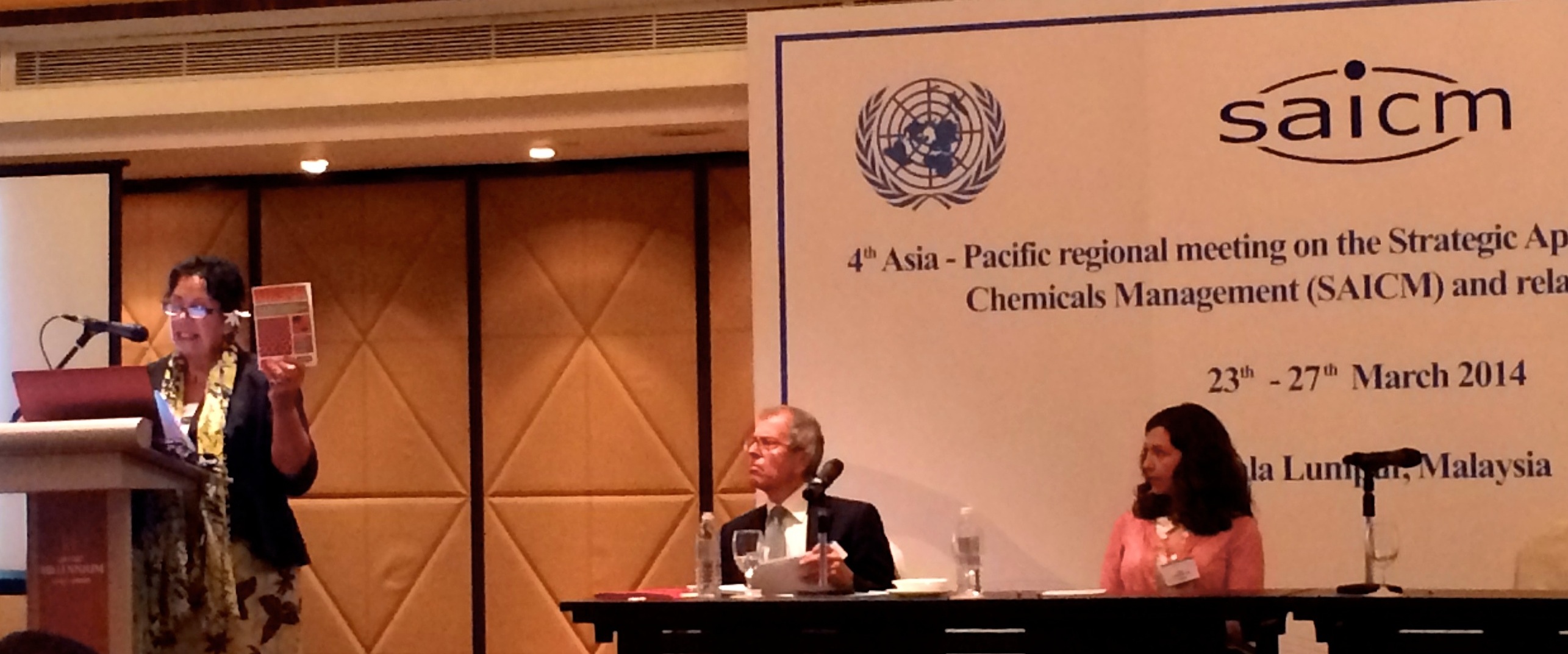4th Asia-Pacific Regional Meeting on the Strategic Approach to International Chemicals Management Passes Resolutions on Pesticides, EDCs, Lead Paint and Financing

NGO representatives at the Asia Pacific regional SAICM meeting in Kuala Lumpur
Numerous IPEN Participating Organization representatives attended the 4th Asia-Pacific regional meeting on the Strategic Approach to International Chemicals Management (SAICM) and related workshops, which occured from 23 - 27 March in Kuala Lumpur, Malaysia. The meeting and workshops were preceded by a South East Asian sub-regional wokshop in support of the ratification and early implementation of the Minamata Convention on Mercury. The SAICM meeting covered issues such as endocrine disrupting chemicals (EDCs), lead in paint, nanotechnology, highly hazardous pesticides and other subjects in the SAICM.
Meeting Outcomes
Agreements and resolutions that were passed at the meeting signify a consensus agreement of 55 countries, chemical and pesticide industries, and public interest civil society representatives.
Endocrine Disrupting Chemicals (EDCs):
The region passed a resolution on EDCs that calls for robust awareness-raising activities and invites UNEP and WHO to develop a report targeted to developing and transition countries. The resolution also recommends case studies on EDCs in pesticides, children’s products, building products, and electrical and electronic products.
Highly Hazardous Pesticides (HHPs):
The region agreed to survey HHP use and to exchange information about actions taken to prohibit, restrict and replace HHPs. Many countries and stakeholders invited FAO to develop an information paper for the 4th International Conference on Chemicals Management (ICCM4). on safer alternatives to HHPs.
Lead in Paint:
The region agreed on a resolution that calls on countries to promote regulatory frameworks and requests UNEP to consider organizing a regional Asia Pacific workshop at which multi-stakeholder participants can receive information, training and advice on how to eliminate lead paint. The resolution invites UNEP and others to support the environmentally sound management of lead paint wastes in developing and transition countries. Finally, the resolution requests WHO to assist with efforts to conduct regular biomonitoring.
Finance:
The region agreed on a resolution on financing SAICM that calls on donors to the Quick Start Programme to ensure that they meet their political commitment to funding and to continue to make all efforts to mobilize existing and new predictable, sustainable and dedicated sources of financial support. The resolution requests the Executive Director of UNEP and the Director General of WHO to provide human and other resources to fully staff the SAICM secretariat. Finally, the resolution encourages the Asia-Pacific Coordination Group to investigate and perform outreach activities to identify financial partners and donors to fund SAICM implementation projects of the Asia-Pacific region.
Official resolutions should be available by the end of May (approximately). Please see the SAICM website for more information.
Publications
IPEN distributed a new publication on nanotechnology: Social and Environmental Implications of Nanotechnology Development in Asia-Pacific and also circulated booklets on lead in paint.
Information Sharing Sessions
IPEN hosted two information sharing sessions during the meeting; one about lead in paint activities and one about regional work on nanomaterials.
Lead in Paint
An information sharing session was held on 25 March that provided a platform to introduce IPEN’s Asian Lead Paint Elimination Project, reveal the findings of the IPEN study on the lead content of oil-based decorative paints in Bangladesh, India, Indonesia, Nepal, Philippines, Sri Lanka and Thailand, and draw attention to IPEN's recommendations. Presentations were provided regarding 1) the Global Alliance to Eliminate Lead in Paint (GAELP) and its business plan (presented by Lesley Onyon, Regional Advisor, WHO-SEARO); 2) the results of the nine-country lead in decorative paints study by UNEP and IPEN (presented by Shiela Logan of UNEP Chemicals); 3) the results of the seven-country lead in decorative paints study by IPEN and its partner groups in Asia (presented by Hemantha Withanage, Sub-Regional Specialist, IPEN Asian Lead Paint Elimination Project); 4) a report on 2013 International Lead Poisoning Prevention Week of Action (presented by WHO); and 5) the Chemical Control Order for Lead and Lead Compounds (presented by Renato Cruz, Department of Environment and Natural Resources – Environmental Management Bureau, Philippines). Copies of the IPEN’s “Asia Regional Paint Report” and the EcoWaste Coalition’s “Eliminate Lead Paints” poster were made available to the participants.
Nanomaterials
On 27 March a presentation was given about regional work on nanomaterials. David Azoulay from the Center from International Environmental Law presented the majority of information, but it also included a number of country- specific presentations from IPENers Sarojeni Rengam (PAN Asia Pacific) on Malaysia, Yuyun Ismawati (BaliFokus) on Indonesia, Jayan Chelaton (Thanal) on India, Lee Bell (National Toxics Network) on Australia, and Meriel Watts (PAN Aotearoa NZ) on New Zealand. Additionally, at the end of the session the deputy director of the Thai Nanotec Center made a presentation.

Media
An article about lead in paint, a new IPEN study on lead in paint in seven Asian countries and the SAICM meeting in Malaysia was recently released by Huffington Post.
IPEN Closing Statement
Thank you Mr Chair. The participating public interest groups in this meeting would like to convey our earnest appreciation and thanks to all SAICM stakeholders and the Secretariat for making the 4th Asia Pacific Regional Meeting a success in terms of providing us with an open space to share information and knowledge, exchange experience and expertise, and deliberate and agree on important messages from the region for the upcoming OEWG and ICCM4. The meaningful conclusion of this meeting is concrete proof of our potentials and strengths as a region to tackle key challenges and issues and come up with points of agreement despite our rich diversity. We hope that our unity to listen, collaborate and act will be sustained and bear more fruits through a revitalized Coordination Committee.
As we adjourn this meeting and prepare for our flights home, please allow me to remind you of a beautiful statement of unity from SAICM’s Dubai Declaration, which says: “We commit ourselves in a spirit of solidarity and partnership to achieving chemical safety and thereby assisting in fighting poverty, protecting vulnerable groups and advancing public health and human security.”
Let’s stay true to this commitment and work together with all the stakeholders, especially with public interest groups and the most susceptible populations, to ensure that the aspirations of SAICM, which are the aspirations of our people, are fulfilled in the most meaningful and accelerated way.
Prior to the Meeting:
Thought Starters
IPEN, in collaboration with Pesticide Action Network (PAN), submitted "thought starter" documents on highly hazardous pesticides and SAICM and endocrine disrupting pesticides and SAICM.
Resolutions
IPEN also submitted three draft resolutions on lead in paint, EDCs and highly hazardous pesticides.

